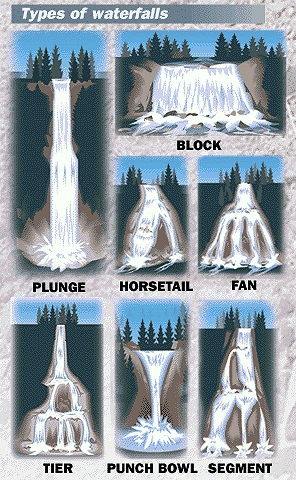The Geological Formation of the Blue
Hole
Typically, a river or in this case Mill Creek, flows over a
large step in the rocks which may have been formed by a fault line.
Over a period of years, the edges of this shelf will gradually
break away and the waterfall will steadily retreat upstream,
creating a gorge of recession. Often, the rock stratum just below
the more resistant shelf will be of a softer type, meaning
undercutting, due to splashback, will occur here to form a shallow
cave-like formation known as a rock shelter or plunge pool under
and behind the waterfall. Eventually, the outcropping, more
resistant cap rock will collapse under pressure to add blocks of
rock to the base of the waterfall. These blocks of rock are then
broken down into smaller boulders by attrition as they collide with
each other, and they also erode the base of the waterfall by
abrasion, creating a deep plunge pool.
Mill Creek becomes wider and more shallow just above waterfalls
due to flowing over the rock shelf, and there is a deep pool just
below the waterfall because of the kinetic energy of the water
hitting the bottom.
At the Blue hole, you will see what the Mill Creek has done
which results in all of this beauty.
There are several types of
waterfalls:
BLOCK: the water descends from a relatively wide stream or
river
CASCADE: the water descends a series of rock steps
CATARACT: A large waterfall
FAN: water spreads horizonally as it desends whileremaining
in contact with bedrock
Horsetail: The desending water maintains some contact with
bedrock
PLUNGE: the water desends vertically, losing contact with
the bedrock surface
PUNCHBOWL: water desends in a constricted form, then spreads
out in a wider pool
SEGMENTED: separate (distinctly) flows of water form as it
desends
TIERED: the water drops in a series of distinct steps or
falls
MULTI-STEP: a series of waterfalls one after another of
roughly the same size with each its own sunken plunge pool
 Some Of The Types, Which One Am I?
Some Of The Types, Which One Am I?
This magnificant waterfall and pool took millions of years
to form so enjoy and take care of it.
Note In order to receive credit for the Earthcache
you must do the following:
1. Email us the answers to the following:
A. Estimate the height of the waterfall (need to be within +/- 10
feet)
B. Estimate the width of the waterfall (need to be within +/- 10
feet)
C. Using the above classification, what type of waterfall is the
Blue Hole?
2. Upload a picture of your GPSr pointing to the front of the
waterfall. While it would be nice, you do not have to have to show
your face(s) in the photo.
We hope you have enjoyed this little bit of geology as much
as we did. We are certainly not
geologists………..far from it! We have found the
subject becoming more and more interesting so from a strictly
amateur point of view, we simply want to share these wonderful
local geological phenomena with you. We are learning as we go
along.
This Earthcache was approved by the
Geological Society of America
| We have earned GSA's highest level: |
 |